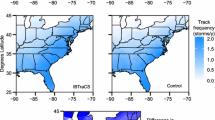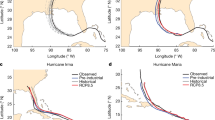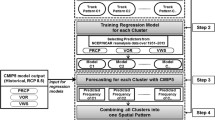Abstract
In this paper, U.S. landfalling tropical cyclone (TC) activity is projected for the late twenty-first century using a two-step dynamical downscaling framework. A regional atmospheric model, is run for 27 seasons, to generate tropical storm cases. Each storm case is -resimulated (up to 15 days) using the higher-resolution Geophysical Fluid Dynamics Laboratory hurricane model. Thirteen CMIP3 or CMIP5 climate change scenarios are explored. Robustness of projections is assessed using statistical significance tests and comparing changes across models. The proportion of TCs making U.S. landfall increases for the warming scenarios, due, in part, to an increases in the percentage of TC genesis near the U.S. coast and a change in climatological steering flows favoring more U.S. landfall events. The increases in U.S. landfall proportion leads to an increase in U.S. landfalling category 4–5 hurricane frequency, averaging about + 400% across the models; 10 of 13 models/ensembles project an increase (which is statistically significant in three of 13 models). We have only tentative confidence in this latter increase, which occurs despite a robust decrease in Atlantic basin category 1–5 hurricane frequency, no robust change in Atlantic basin category 4–5 and U.S. landfalling category 1–5 hurricane frequency, and no robust change in U.S. landfalling hurricane intensities. Rainfall rates, averaged within a 100-km radius of the storms, are projected to increase by about 18% for U.S. landfalling TCs. Important caveats to the study include low correlation (skill) for interannual variability of modeled vs. observed U.S. TC landfall frequency and model bias of excessive TC genesis near and east of the U.S. east coast in present-day simulations.








Similar content being viewed by others
Data availability
The datasets generated during and/or analyzed during the current study are available from the corresponding author on reasonable request. There are no special materials involved in the study.
References
Bender MA, Knutson TR, Tuleya RE, Sirutis JJ, Vecchi GA, Garner ST, Held IM (2010) Modeled impact of anthropogenic warming on the frequency of intense Atlantic hurricanes. Science 327:5964. https://doi.org/10.1126/science.1180568
Chen JH, Lin SJ (2013) Seasonal predictions of tropical cyclones using a 25-km resolution general circulation model. J Clim 26(2). https://doi.org/10.1175/JCLI-D-12-00061.1
Colbert AJ, Soden BJ, Vecchi GA, Kirtman BP (2013) The impact of anthropogenic climate change on North Atlantic tropical cyclone tracks. J Clim 26(12):4088–4095
Dunstone N, Smith D, Booth B et al (2013) Anthropogenic aerosol forcing of Atlantic tropical storms. Nat Geosci 6:534–539. https://doi.org/10.1038/ngeo1854
Emanuel KA (1987) The dependence of hurricane intensity on climate. Nature 326:483–485. https://doi.org/10.1038/326483a0
Emanuel KA (2015) Effect of upper-ocean evolution on projected trends in tropical cyclone activity. J Clim 28:8165–8170. https://doi.org/10.1175/JCLI-D-15-0401.1
Garner AJ, Kopp RE, Horton BP (2021) Evolving tropical cyclone tracks in the North Atlantic in a warming climate. Earth’s Futur 9: e2021EF002326. https://doi.org/10.1029/2021EF002326
Gori A, Lin N, Xi D, Emanuel K (2022) Tropical cyclone climatology change greatly exacerbates US extreme rainfall-surge hazard. Nat Clim Chang 12:171–178
Hassanzadeh P, Lee CY, Nabizadeh E et al (2020) Effects of climate change on the movement of future landfalling Texas tropical cyclones. Nat Comm 11:3319. https://doi.org/10.1038/s41467-020-17130-7
Held IM, Soden BJ (2006) Robust responses of the hydrological cycle to global warming. J Clim 19(21):5686–5699
Hill KA, Lackmann GM (2011) The impact of future climate change on TC intensity and structure: a downscaling approach. J Clim 24(17):4644–4661
Hsieh TL, Vecchi G, Yang W, Held I, Garner S (2020) Large-scale control on the frequency of tropical cyclones and seeds: a consistent relationship across a hierarchy of global atmospheric models. Clim Dyn 55:3177–3196
Huang P, Lin II, Chou C, Huang RH (2015) Change in ocean subsurface environment to suppress tropical cyclone intensification under global warming. Nat Comm 6:7188. https://doi.org/10.1038/ncomms8188
Kalnay E et al (1996) The NCEP/NCAR 40-year re-analysis project. Bull Am Meteorol Soc 77:437–471
Klotzbach PJ et al (2020) Surface pressure a more skillful predictor of normalized hurricane damage than maximum sustained wind. Bull Am Meteorol Soc 101(6):E830–E846. https://doi.org/10.1175/BAMS-D-19-0062.1
Knapp KR, Kruk MC, Levinson DH, Gibney EJ (2009) Archive compiles a new resource for global tropical cyclone research. Eos Trans AGU 90. https://doi.org/10.1029/2009EO060002
Knutson T et al (2020) Tropical cyclones and climate change assessment: part II: projected response to anthropogenic warming. Bull Am Meteorol Soc 101(3):E303–E322
Knutson TR, Sirutis JJ, Garner ST, Held IM, Tuleya RE (2007) Simulation of the recent multidecadal increase of Atlantic hurricane activity using an 18-km-grid regional model. Bull Am Meteorol Soc 88(10). https://doi.org/10.1175/BAMS-88-10-1549
Knutson TR, Sirutis JJ, Vecchi G, Garner ST, Zhao M, Kim HS, Bender MA, Tuleya RE, Held IM, Villarini G (2013) Dynamical downscaling projections of 21st century Atlantic hurricane activity: CMIP3 and CMIP5 model-based scenario. J Clim 26(17). https://doi.org/10.1175/JCLI-D-12-00539.1
Knutson T, Sirutis JJ, Zhao M, Tuleya R, Bender M, Vecchi G, Villarini G, Chavas D (2015) Global projections of intense tropical cyclone activity for the late 21st century from dynamical downscaling of CMIP5/RCP4.5 scenarios. J Clim 28(18).https://doi.org/10.1175/JCLI-D-15-0129.1
Kossin J (2017) Hurricane intensification along United States coast suppressed during active hurricane periods. Nature 541:390–393. https://doi.org/10.1038/nature20783
Kossin JP (2019) Reply to: Moon, I.-J. et al.; Lanzante, J. R. Nature 570:E16–E22. https://doi.org/10.1038/s41586-019-1224-1
Levin EL, Murakami H (2019) Impact of anthropogenic climate change on United States major hurricane landfall frequency. J Mar Sci Eng 7:135. https://doi.org/10.3390/jmse7050135
Liu M, Vecchi GA, Smith JA, Murakami H (2018) Projection of landfalling–tropical cyclone rainfall in the eastern United States under anthropogenic warming. J Clim 31(18):7269–7286
Liu M, Vecchi GA, Smith JA, Knutson TR (2019) Causes of large projected increases in hurricane precipitation rates with global warming. NPJ Clim Atmos Sci 2:38. https://doi.org/10.1038/s41612-019-0095-3
Murakami H, Wang B (2010) Future change of North Atlantic tropical cyclone tracks: projection by a 20-km-mesh global atmospheric model. J Clim 23(10):2699–2721
Murakami H, Vecchi GA, Villarini G, Delworth TL, Gudgel R, Underwood S, Yang X, Zhang W, Lin SJ (2016) Seasonal forecasts of major hurricanes and landfalling tropical cyclones using a high-resolution GFDL coupled climate model. J Clim 29:7977–7989
Murakami H, Delworth TL, Cooke WF, Zhao M, Xiang B, Hsu PC (2020) Detected climatic change in global distribution of tropical cyclones. Proc Nat Acad Sci 117(20):10706–10714. https://doi.org/10.1073/pnas.1922500117
Patricola CM, Wehner MF (2018) Anthropogenic influences on major tropical cyclone events. Nature 563:339–346. https://doi.org/10.1038/s41586-018-0673-2
Pielke RA Jr, Gratz J, Landsea CW, Collins D, Saunders MA, Musulin R (2008) Normalized hurricane damage in the United States: 1900–2005. Nat Hazards Rev 9:29. https://doi.org/10.1061/(ASCE)1527-6988(2008)9:1(29)
Reed KA, Wehner MF, Stansfield AM, Zarzycki CM (2021) Anthropogenic influence on Hurricane Dorian’s extreme rainfall. [In “Explaining extremes of 2019 from a climate perspective”]. Bull Am Meteorol Soc 102(1):S9–S15. https://doi.org/10.1175/BAMS-D-20-0160.1
Stansfield AM, Reed KA, Zarzycki CM (2020) Changes in precipitation from North Atlantic tropical cyclones under RCP scenarios in the variable-resolution community atmosphere model. Geophys Res Lett 47: e2019GL086930. https://doi.org/10.1029/2019GL086930
Ting M, Kossin JP, Camargo SJ et al (2019) Past and future hurricane intensity change along the U.S. East Coast. Sci Rep 9:7795. https://doi.org/10.1038/s41598-019-44252-w
Tuleya RE, Bender M, Knutson TR, Sirutis JJ, Thomas B, Ginis I (2016) Impact of upper-tropospheric temperature anomalies and vertical wind shear on tropical cyclone evolution using an idealized version of the operational GFDL hurricane model. J Atmos Sci 73(10):3803–3820
Tuleya R, DeMaria M, Kuligowski RJ (2007) Evaluation of GFDL and simple statistical model rainfall forecasts for U.S. landfalling tropical storms. Weather Forecast 22:56–70. https://doi.org/10.1175/WAF972.1
Vecchi GA, Knutson TR (2008) On estimates of historical North Atlantic tropical cyclone activity. J Clim 21(14). https://doi.org/10.1175/2008JCLI2178.1
Vecchi GA, Knutson TR (2011) Estimating annual numbers of Atlantic hurricanes missing from the HURDAT database (1878–1965) using ship track density. J Clim 24(6):1736–1746. https://doi.org/10.1175/2010JCLI3810.1
Vecchi GA, Landsea C, Zhang W, Villarini G, Knutson TR (2021) Changes in Atlantic major hurricane frequency since the late-19th century. Nat Comm 12:4054. https://doi.org/10.1038/s41467-021-24268-5
Velden CS, Leslie LM (1991) The basic relationship between tropical cyclone intensity and the depth of the environmental steering layer in the Australian region. Weather Forecast 6(2):244–253
Wang CC, Lin BX, Chen CT, Lo SH (2015) Quantifying the effects of long-term climate change on tropical cyclone rainfall using a cloud-resolving model: examples of two landfall typhoons in Taiwan. J Clim 28:66–85. https://doi.org/10.1175/JCLI-D-14-00044.1
Wright D, Knutson TR, Smith JA (2015) Regional climate model projections of rainfall from U.S. landfalling tropical cyclones. Clim Dyn 45:3365–3379. https://doi.org/10.1007/s00382-015-2544-y
Yan X, Zhang R, Knutson TR (2017) The role of Atlantic overturning circulation in the recent decline of Atlantic major hurricane frequency. Nat Comm 8:1695. https://doi.org/10.1038/s41467-017-01377-8
Zhang G, Murakami H, Knutson TR, Mizuta R, Yoshida K (2020) Tropical cyclone motion in a changing climate. Sci Adv, 6(17):eaaz7610. https://doi.org/10.1126/sciadv.aaz7610
Zhao M, Held IM, Lin SJ, Vecchi GA (2009) Simulations of global hurricane climatology, interannual variability, and response to global warming using a 50km resolution GCM. J Clim 22(24). https://doi.org/10.1175/2009JCLI3049.1
Acknowledgements
We thank the CMIP3 and CMIP5 modeling groups for contributing to the CMIP database. We thank the three anonymous reviewers as well as Hiro Murakami and Tim Marchok from GFDL/NOAA for providing valuable comments to improve our manuscript.
Funding
This work was performed by T. Knutson and J. Sirutis as part of their regular job duties as U.S. government employees at GFDL/NOAA, by B. Schenkel as part of his regular job duties as an employee at the NOAA Cooperative Institute for Severe and High-impact Weather Research, and by Morris Bender as part of his regular duties as a Professional Specialist at Princeton University, funded by NOAA award NA18OAR4320123. R. Tuleya was unfunded.
Author information
Authors and Affiliations
Contributions
T. Knutson designed the study, directed Joe Sirtutis on the analysis and model runs, and wrote the manuscript. J. Sirutis, who is now deceased, performed all the model runs and most of the analysis contained in the study. R. Tuleya and M. Bender assisted in the model setup and technical issues for the GFDL hurricane model and assisted in writing the manuscript. B. Schenkel contributed several analysis plots to the paper, and assisted in writing the manuscript.
Corresponding author
Ethics declarations
Ethics approval and consent to participate
Not applicable because the study does not report the results of studies involving humans and/or animals. Consent to participate is not applicable because the study does not report the results of studies involving humans and/or animals.
Consent for publication
Not applicable because the study does not report the results of studies involving humans and/or animals.
Competing interests
The authors declare no competing interests.
Additional information
Publisher's note
Springer Nature remains neutral with regard to jurisdictional claims in published maps and institutional affiliations.
Joseph J. Sirutis is deceased.
Supplementary Information
Below is the link to the electronic supplementary material.
Rights and permissions
About this article
Cite this article
Knutson, T.R., Sirutis, J.J., Bender, M.A. et al. Dynamical downscaling projections of late twenty-first-century U.S. landfalling hurricane activity. Climatic Change 171, 28 (2022). https://doi.org/10.1007/s10584-022-03346-7
Received:
Accepted:
Published:
DOI: https://doi.org/10.1007/s10584-022-03346-7




